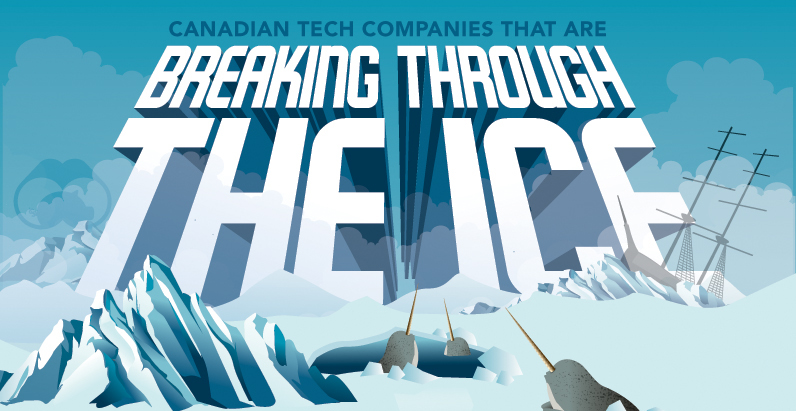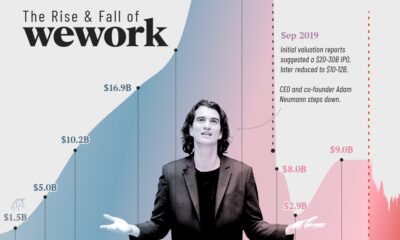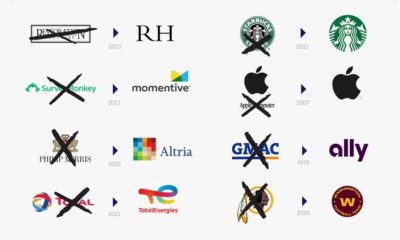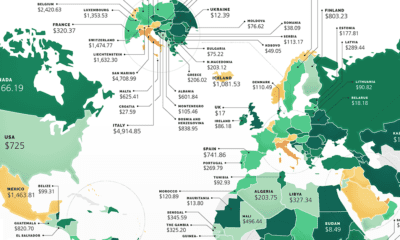Technology
The Narwhal Club: Home to Canada’s $1 Billion Dollar Tech Startups

The Narwhal Club: Home to Canada’s $1 Billion Dollar Tech Startups
Created by Garibaldi Capital Advisors and Visual Capitalist
October 2015 Update:
The Narwhal Club is going strong with plenty of recent news concerning prominent Canadian startups. Working with Brent Holliday from Garibaldi Capital Advisors, we got the latest scoop on the sector and have updated the narwhal list accordingly.
The most recent notable event occurred in the summer of 2015, when Markus Frind sold his 100% owned Plentyoffish.com to Match Group for US$575 million. As a result, we have removed POF from the Narwhal list, and instead have inducted Markus to a new category called the Nar-Wall of Fame. Plentyoffish.com allowed Markus to amass a personal fortune from profits and sale of his business that makes his personal valuation Narwhal-esque.
Next, with its recent raise of $50 million from China’s Tencent, a new narwhal was born. Kik Interactive is now valued at over the coveted $1 billion mark, and claims to have over 240 million users in 230 countries worldwide. Kik is a chatting application that competes directly with the likes of Snapchat among younger demographics.
Lastly, three new “emerging narwhals” have been added to the list. Enerkem uses proprietary technology to convert non-recyclable waste into clean energy products, and most recently raised C$152.6 million from financings. Intelex, a software company providing web-based management systems, is also now on the emerging list after securing C$160 in strategic growth funding. The third new entry is Lightspeed POS, a company that just raised US$61 million in September for its point-of-sales systems.
The Narwhal Club
Original writeup published December 2014
In 2013, Aileen Lee of Kleiner Perkins Caufield & Byers came up with the concept of the “Unicorn Club”, for tech startups reaching valuations of $1 billion or more. For venture capitalists, this number is much like unicorns themselves – very magical. It resembles big potential exits that can make up for all the startup investments that don’t pan out.
Brent Holliday at Garibaldi Capital Advisors, a Vancouver-based capital advisory with a focus on technology, thought there needed to be a Canadian equivalent. He created the concept of the “Narwhal Club”, based on the uni-horned Canadian animal that actually exists and roams the frigid seas of the North. This club represents companies with $1B CAD valuations that started in 1999 or later.
While there are more than 40 unicorns in existence in the US, there are only four members of the Narwhal Club in Canada: Avigilon, Hootsuite, Slack, and Shopify. However, there are many companies getting close to breaking the ice – these are companies we consider to be emerging narwhals, with valuations in the hundreds of millions with great growth rates.
Some of these include Desire2Learn, Vision Critical, Redknee, Real Matters, iQmetrix, PointClickCare, BuildDirect, DWave, and Wattpad.
We will be updating this list quarterly based on the latest public financing round available. If you know of a company that could fit either category, contact us here. Alternatively, connect with us below.
Technology
Ranked: Semiconductor Companies by Industry Revenue Share
Nvidia is coming for Intel’s crown. Samsung is losing ground. AI is transforming the space. We break down revenue for semiconductor companies.
Semiconductor Companies by Industry Revenue Share
This was originally posted on our Voronoi app. Download the app for free on Apple or Android and discover incredible data-driven charts from a variety of trusted sources.
Did you know that some computer chips are now retailing for the price of a new BMW?
As computers invade nearly every sphere of life, so too have the chips that power them, raising the revenues of the businesses dedicated to designing them.
But how did various chipmakers measure against each other last year?
We rank the biggest semiconductor companies by their percentage share of the industry’s revenues in 2023, using data from Omdia research.
Which Chip Company Made the Most Money in 2023?
Market leader and industry-defining veteran Intel still holds the crown for the most revenue in the sector, crossing $50 billion in 2023, or 10% of the broader industry’s topline.
All is not well at Intel, however, with the company’s stock price down over 20% year-to-date after it revealed billion-dollar losses in its foundry business.
| Rank | Company | 2023 Revenue | % of Industry Revenue |
|---|---|---|---|
| 1 | Intel | $51B | 9.4% |
| 2 | NVIDIA | $49B | 9.0% |
| 3 | Samsung Electronics | $44B | 8.1% |
| 4 | Qualcomm | $31B | 5.7% |
| 5 | Broadcom | $28B | 5.2% |
| 6 | SK Hynix | $24B | 4.4% |
| 7 | AMD | $22B | 4.1% |
| 8 | Apple | $19B | 3.4% |
| 9 | Infineon Tech | $17B | 3.2% |
| 10 | STMicroelectronics | $17B | 3.2% |
| 11 | Texas Instruments | $17B | 3.1% |
| 12 | Micron Technology | $16B | 2.9% |
| 13 | MediaTek | $14B | 2.6% |
| 14 | NXP | $13B | 2.4% |
| 15 | Analog Devices | $12B | 2.2% |
| 16 | Renesas Electronics Corporation | $11B | 1.9% |
| 17 | Sony Semiconductor Solutions Corporation | $10B | 1.9% |
| 18 | Microchip Technology | $8B | 1.5% |
| 19 | Onsemi | $8B | 1.4% |
| 20 | KIOXIA Corporation | $7B | 1.3% |
| N/A | Others | $126B | 23.2% |
| N/A | Total | $545B | 100% |
Note: Figures are rounded. Totals and percentages may not sum to 100.
Meanwhile, Nvidia is very close to overtaking Intel, after declaring $49 billion of topline revenue for 2023. This is more than double its 2022 revenue ($21 billion), increasing its share of industry revenues to 9%.
Nvidia’s meteoric rise has gotten a huge thumbs-up from investors. It became a trillion dollar stock last year, and broke the single-day gain record for market capitalization this year.
Other chipmakers haven’t been as successful. Out of the top 20 semiconductor companies by revenue, 12 did not match their 2022 revenues, including big names like Intel, Samsung, and AMD.
The Many Different Types of Chipmakers
All of these companies may belong to the same industry, but they don’t focus on the same niche.
According to Investopedia, there are four major types of chips, depending on their functionality: microprocessors, memory chips, standard chips, and complex systems on a chip.
Nvidia’s core business was once GPUs for computers (graphics processing units), but in recent years this has drastically shifted towards microprocessors for analytics and AI.
These specialized chips seem to be where the majority of growth is occurring within the sector. For example, companies that are largely in the memory segment—Samsung, SK Hynix, and Micron Technology—saw peak revenues in the mid-2010s.
-

 Green2 weeks ago
Green2 weeks agoRanked: Top Countries by Total Forest Loss Since 2001
-

 Travel1 week ago
Travel1 week agoRanked: The World’s Top Flight Routes, by Revenue
-

 Technology1 week ago
Technology1 week agoRanked: Semiconductor Companies by Industry Revenue Share
-

 Money2 weeks ago
Money2 weeks agoWhich States Have the Highest Minimum Wage in America?
-

 Real Estate2 weeks ago
Real Estate2 weeks agoRanked: The Most Valuable Housing Markets in America
-

 Markets2 weeks ago
Markets2 weeks agoCharted: Big Four Market Share by S&P 500 Audits
-

 AI2 weeks ago
AI2 weeks agoThe Stock Performance of U.S. Chipmakers So Far in 2024
-

 Automotive2 weeks ago
Automotive2 weeks agoAlmost Every EV Stock is Down After Q1 2024














